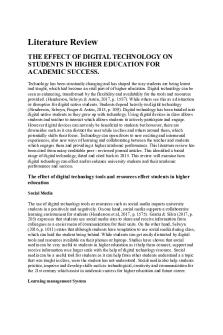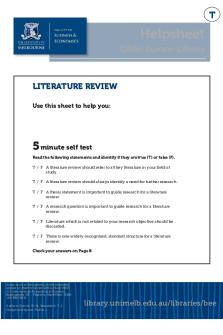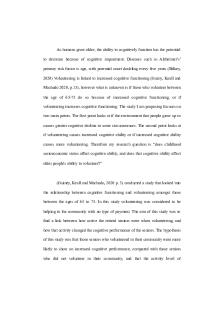AMB202 Literature Review PDF

| Title | AMB202 Literature Review |
|---|---|
| Author | Jessica Seddon |
| Course | IMC |
| Institution | Queensland University of Technology |
| Pages | 8 |
| File Size | 148.1 KB |
| File Type | |
| Total Downloads | 21 |
| Total Views | 125 |
Summary
Literature Review for AMB202 . ...
Description
DUE: Sunday 18 August, 2019
AMB202: Comparing and Analysing the Differences between Digitial and Social Media Assessment 1: Literature Review
Abstract
Methods of marketing communications are constantly changing and thus continue to present challenges initiated through new media outlets. A combination of social and digital media platforms is crucial for brand success in today’s market. Drawing upon an evaluation of current academic literature, this review aims to critically analyse and highlight the key similarities and differences between social and digital media.
Table of Contents Literature Review...............................................................................................................4 Conclusion and Ongoing Research......................................................................................5 References.........................................................................................................................6
Literature Review INTEGRATED MARKETING COMMUNICATION & INTRODUCTION TO DIGITAL MEDIA Marketers are confronted with several challenges when scheming integrated marketing communications as a result of consumer profiles, brands and media platforms that are fundamentally evolving (Lamberton & Stephen, 2016). Historically, the introduction of new media reasons a significant alteration in consumer media usage patterns (Haubl & Trifts, 2000). The way in which consumers utilize alternate media resources to gather data, has been proven to influence when, where and how they select the organisations in which they will willingly invest their time and money (Ghotbifar, 2017; Fierro et al, 2017).
DIGITAL MEDIA AND SOCIAL MEDIA – WHAT’S THE DIFFERENCE? Throughout the past three decades, the introduction of the internet has founded many new media platforms that businesses use to implement their marketing strategies as a means to interact, focus and communicate with their target audiences (Hemann & Burbary, 2013; Lamberton & Stephen, 2016)). This communication channel is now commonly known as Digital Marketing. When digital marketing was first introduced, its key objective was solely evolved around advertising to the consumer (Beer, 2010). Furthermore, the digital revolution throughout the 2000s has given rise to the emergence of new social media and mobile tools (Lamberton & Stephen, 2016). A collation of multiple academic sources has provided four main aspects of digital marketing that are inclusive of, but not limited to: web/mobile marketing, search engine marketing (SEO), social media/networks and customer relationship management (CRM) (Bruyn, 2008; Kannan, 2017; & Fierro et al, 2017).
The relationship between digital media and social media is closely related (Beer, 2010). However, the factor that separates these two concepts is that digital media is an overarching term for any mode of media marketing that is either online or digital. The term, social media, is categorised as a subset of digital media that can be defined as “a group of internet-based applications that build on the ideological and technological foundations of Web 2.0, and that allow the creation and exchange of user generated content” (Kaplan & Haenlein, 2010). Social media platforms may involve the following: social networking sites,
namely Facebook and Instagram; professional networking platforms such as LinkedIn, media sharing sites such as YouTube and TikTok, as well as commerce communities, for example, Amazon (Agarwal & Yiliyasi, 2010).
Setting categorical differences aside, a combination of digital and social media is a necessity for business success (Danaher et al, 2010; Grewal et al, 2016; Kannan, 2017). Empirical studies have concluded that the consumer path to purchase is profoundly different today in comparison to the early 1990s and even 2000s (Ghose & Han, 2011; Das & Subudhi, 2016; Brosnan, 2012). It is often of a shorter duration, less hierarchical and more complex (Bucklin & Sismeiro, 2003). Consumers will no longer receive passive brand stimuli strictly through traditional media; as studies have revealed that this method is stored in the memory for later use (Valos et al, 2016). Alternatively, consumers will now actively obtain this information when desired, via search engines, mobile sites, blogs and company websites (Albuquerque et al, 2012; Hemann & Burbary, 2013). It is through these means that social media generates many advantages such as the ability to communicate with consumers globally, improve customer service, permits timely and cost-effective research and most significantly, it can be accessed continuously; aligning with the newer generation’s attitudes and values of convenience and simplicity (Valos et al, 2016).
Conclusion and Ongoing Research In summary, it is recommended that to increase brand equity, organisations must implement a mix of digital and social media to achieve engagement with stakeholders to sustain customer loyalty and meaningful relationships. For future progression, marketers should aim to investigate the effectiveness of different communication channels on segmented markets such as age, gender and culture to achieve optimal results.
References Albuquerque, P., Pavlidis, P., Chatow, U., Chen, K., & Jamal, Z. (2012). Evaluating Promotional Activities in an Online Two-Sided Market of User-Generated Content. Marketing Science, 31(3), 406–32. doi: 10.1287/mksc.1110.0685
Agarwal, N., & Yiliyasi, Y. (2010). Information quality challenges in social media. The 15th International Conference on Information Quality (ICIQ), Little Rock, AR, 12-14 November.
Beer, J. (2010). New Survey Targets Digital Marketing. Marketing Magazine, 115(17), 13.
Brosnan, F. (2012). Business intelligence: What works where in B2B digital marketing. Journal of Direct, Data and Digital Marketing Practice, 14(2), 154-159. doi: 10.2164/jdmk.1112.1786
Bruyn, A. D. (2008). A multi-stage model of word-of-mouth influence through viral marketing. International Journal of Research in Marketing, 25 (3), 151– 163. doi: 10.1016/j.jiredmar.2008.03.004
Bucklin, R. E., & Sismeiro, C. (2003). A Model of Web Site Browsing Behaviour Estimated on Clickstream Data. Journal of Marketing Research, 40 (1), 249–67. doi: 10.1509/jmkr.40.3.249.19241
Danaher, P. J., Lee, J., & Kerbache, L. (2010). Optimal Internet Media Selection. Marketing Science, 29(2), 336–47.
Das, B. B., & Subudhi, R. N. (2016). Engagement Pattern of Customers in Digital and Social Media Marketing: A Study of Effect of Age Group. KIIT Journal of Management, 12(1), 18-29. Retrieved from https://gateway.library.qut.edu.au/login?url=https://searchproquest-com.ezp01.library.qut.edu.au/docview/1786466138?accountid=13380
Fierro, I., Gavilanez, J., Arbelaez, D. A. (2017). Digital Marketing. Barranquilla, 43(1), 242256. doi: 10.14482/pege.41.9704
Ghose, A., & Han, S. P. (2011). An Empirical Analysis of User Content Generation and Usage Behavior on the Mobile Internet. Management Science, 57(9), 1671–91. doi: 10.1287/mnsc.1110.1350
Ghotbifar, F. (2017). Identifying and assessing the factors affecting skill gap in digital marketing in communication industry companies. Independent Journal of Management & Production, 8(1), 1- 14.
Grewal, D., Bart, Y., Spann, M., & Zubcsek, P. P. (2016). Mobile Advertising: A Framework and Research Agenda. Journal of Interactive Marketing, 34 (5), 3–14. Retrieved from https://www.sciencedirect.com/journal/journal-of-interactive-marketing/vol/34
Haubl, G., & Trifts, V. (2000). Consumer Decision Making in Online Shopping Environments: The Effects of Interactive Decision Aids. Marketing Science, 19(1), 4–21. doi: 10.1287/mksc.19.1.4.15178
Hemann, C., & Burbary, K. (2013). Digital Marketing Analytics: Making Sense of Consumer Data in a Digital World (1st ed.). Retrieved from https://learning.oreilly.com/library/view/digital-marketinganalytics/9780133150933/copyright.html
Kannan, P. (2017). Digital marketing: A framework, review and research agenda. International Journal of Research in Marketing , 34(1), 22-45. doi: 10.1016/j.ijresmar.2016.11.006
Kaplan, A. M., & Haenlein, M. (2010). Users of the world, the challenges and opportunities of social media. Business Horizons, 53(1), 59-68. doi: 10.1016/j.bushor.2009.09.003
Lamberton, C., & Stephen, A. T. (2016). A Thematic Exploration of Digital, Social Media and Mobile Marketing: Research Evolution from 2000 to 2015 and an Agenda for Future Inquiry. Journal of Marketing, 80(AMA Special Issue), 146 – 172. doi: 10.1509/jm.15.0415
Valos, M., Haji, F., Casidy, R., Driesener, C., & Maplestone, L. (2016). Exploring the integration of social media within integrated marketing communication frameworks. Marketing Intelligence & Planning, 34(1), 19-40. doi:10.1108/MIP-09-2014-0169...
Similar Free PDFs

AMB202 Literature Review
- 8 Pages

Literature Review
- 10 Pages

Literature Review
- 9 Pages

Literature Review
- 6 Pages

Literature Review
- 32 Pages

Literature Review
- 9 Pages

Literature Review
- 5 Pages

Literature Review
- 15 Pages

Literature Review
- 4 Pages

Literature Review
- 16 Pages

Systematic Literature Review
- 9 Pages

Mobile Learning Literature Review
- 26 Pages

Literature review on IFRS
- 11 Pages

Literature Review - guidelines
- 4 Pages

Chapter-2: LITERATURE REVIEW
- 48 Pages
Popular Institutions
- Tinajero National High School - Annex
- Politeknik Caltex Riau
- Yokohama City University
- SGT University
- University of Al-Qadisiyah
- Divine Word College of Vigan
- Techniek College Rotterdam
- Universidade de Santiago
- Universiti Teknologi MARA Cawangan Johor Kampus Pasir Gudang
- Poltekkes Kemenkes Yogyakarta
- Baguio City National High School
- Colegio san marcos
- preparatoria uno
- Centro de Bachillerato Tecnológico Industrial y de Servicios No. 107
- Dalian Maritime University
- Quang Trung Secondary School
- Colegio Tecnológico en Informática
- Corporación Regional de Educación Superior
- Grupo CEDVA
- Dar Al Uloom University
- Centro de Estudios Preuniversitarios de la Universidad Nacional de Ingeniería
- 上智大学
- Aakash International School, Nuna Majara
- San Felipe Neri Catholic School
- Kang Chiao International School - New Taipei City
- Misamis Occidental National High School
- Institución Educativa Escuela Normal Juan Ladrilleros
- Kolehiyo ng Pantukan
- Batanes State College
- Instituto Continental
- Sekolah Menengah Kejuruan Kesehatan Kaltara (Tarakan)
- Colegio de La Inmaculada Concepcion - Cebu
